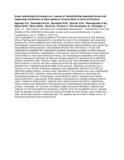| dc.description.abstract | Land degradation is a major problem in the semi-arid environments of Sub-Saharan Africa. Fighting land degradation is essential to ensure the sustainable and long-term productivity of the inhabited semi-arid lands. Cenchrus ciliaris (African foxtail grass), Enteropogon macrostachyus (bush rye) and Eragrostis superba (Maasai love grass) are important perennial grasses in the Eastern African semi-arid lands. A study was conducted to establish the contribution of these indigenous grasses in improving soil hydrological properties, rehabilitation, food security and the livelihoods of agro-pastoral communities in semi-arid districts of Kenya. Soil hydrological properties were tested using a Kamphorst simulator at different stubble heights to represent three different grazing intensities (low, medium, high). Ground cover was estimated using the steppoint method. A survey was also conducted across 50 agro-pastoral households to establish the multidimensional benefits of the grasses. Sediment production (as a function of run-off and infiltration capacity) was significantly different (P<0.05) at different stubble heights. Ground cover estimates of the grasses were also significantly different (P<0.05). Cenchrus ciliaris had the greatest influence in improving soil hydrological properties. Enteropogon macrostachyus and E. superba were ranked second and third, respectively. Enteropogon macrostachyus had the greatest ground cover. Cenchrus ciliaris and E. superba were ranked second and third, respectively. These results were attributed to the growth and morphological characteristics of the grasses. Generally, an increase in stubble height increased infiltration capacity and reduced run-off and sediment production. Results from the household survey showed that the grasses provide a source of income through the sale of hay, grass seeds and milk, which also achieve a balanced diet. The grasses also provide a cheap source of thatching materials and livestock feed | en_US |

